Scroll to the bottom to watch the YouTube tutorial.
Learn the basics of different HVAC systems we find inside typical supermarkets and food retailers, understand the basics of how they each work and how they are integrated to make the building functional.
🎁 Download the free Danfoss Smart Store eBook: HERE
Danfoss Smart Store solutions help build the supermarkets of tomorrow. Using integrated systems and monitoring, supermarkets can reduce costs, minimize environmental impact, and gain a competitive advantage—all while ensuring food safety. Learn more about Danfoss Smart Store Solutions in their new eBook, available for free with this link.
Air Curtain HVAC systems
The first thing we usually notice when we enter a store is the air curtain. That’s the blast of air you feel when you enter the building. If it’s a large store we might also find them in the loading bays too.
The air curtain is suspended above the doorway or it might be built into the ceiling. Inside the unit is a blower fan which is driven by a small electric motor, this forces air into a funnel to provide a powerful jet of air. You can also get versions which provide heated and or cooled air.
For heated air it’s pretty common to use a finned tube heat exchanger but alternatively it could use an electrical heating element.
For heating or cooling we can use a heat pump which uses a refrigerant to heat or cool the air depending on the seasons. Additionally, we can integrate this into a VRF heat recovery system to provide heating and cooling to different parts of the store. We’re going to look at this in greater detail a little later in the article.
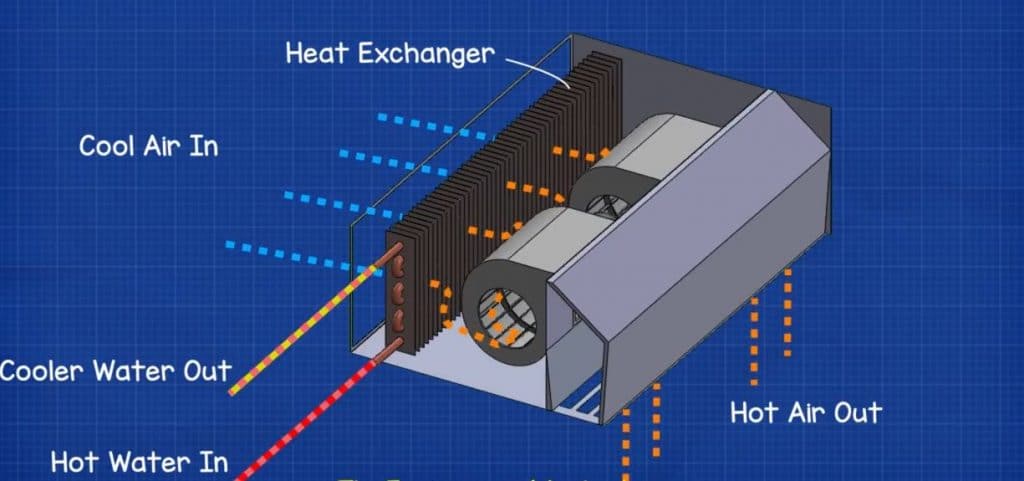
This air curtain creates a barrier between the indoor and outdoor air, the two will be at different temperatures and humidities. The store has had to pay a lot of money to get the indoor air at a certain temperature and humidity so we don’t want that to leave the store and we also don’t want too hot or too cold air from outside coming into the store, so these air curtains will greatly reduce the two mixing. They also prevent dust, dirt and insects from flying into the store.
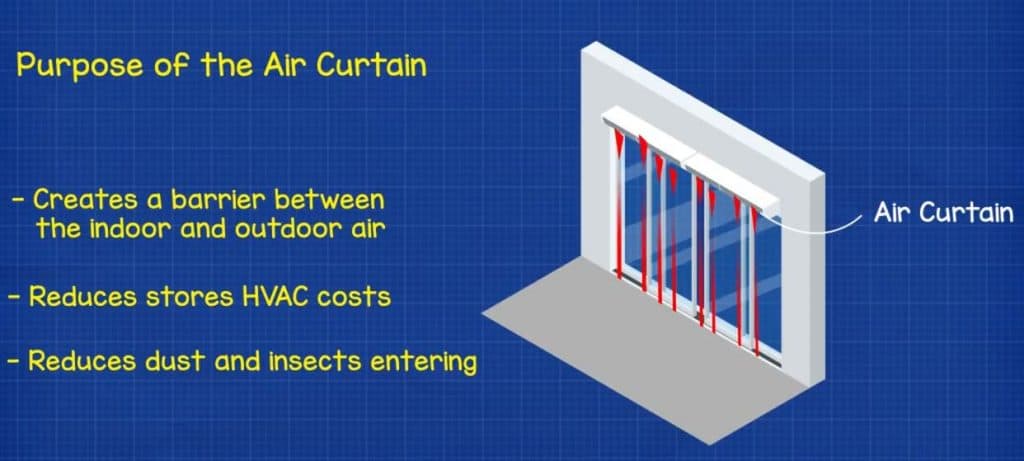
Main Supermarket Ventilation
The next thing we notice is the forced ventilation around the store. In many large supermarkets you’ll see the ductwork for this suspended from the ceiling. The ducts come from either Air Handling Units or Rooftop units. Both do a very similar role although rooftop units are more common in supermarkets simply because they are an all in one HVAC solution.
Rooftop Units
As the name suggests, rooftop units are located on the roof of the supermarket and you’ll usually find multiple units depending on the size of the store. Inside the unit is a large fan which pulls fresh air into the unit and also pushes this into the building, some units use this pushing force to also push the dirty used air out of the building. The air passes through a filter to remove any dust and dirt, it then passes through a heat exchanger where it will be heated or cooled to meet the required conditions.
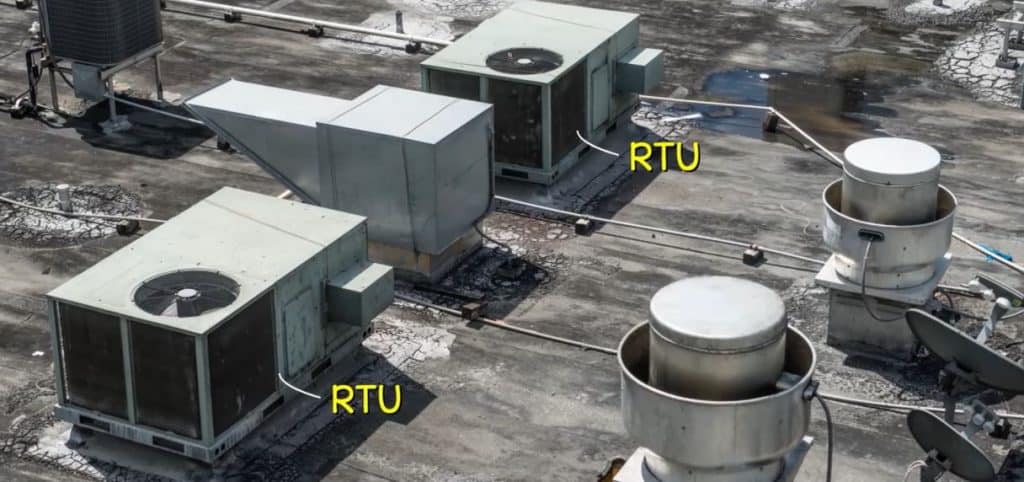
For heating, the rooftop unit uses either an electrical heating element, a gas burner or a heat pump.
For cooling the unit will use either a split air conditioning unit or a heat pump.
For more information on roof top units CLICK HERE.
Air Handling Units
Air handling units work in a very similar way although these are usually much larger and typically housed indoors. These units will also filter, heat, cool and humidify the air although the heating and cooling is provided by a remotely connected chiller and boiler. There will also be an exhaust AHU to maintain pressure in the building and extract the used air. If the returning air is within certain limits of C02, humidity and temperature then some of it can be recirculated to reduce the heating or cooling load.
For more information on air handling units CLICK HERE.
Fan Coil Units
If you look up at the ceiling in large stores you might see a large box connected to a short run of ductwork. This box is a fan coil unit. Inside the fan coil unit is a fan with a small motor, a filter and also one or two heat exchangers. The fan coil just circulates air locally within the building and tops up the heating or cooling to this local area as needed. They also help to distribute fresh air within the building.
The fan coil units can provide heating and or cooling and the heat exchangers will be connected to either a heat pump, VRF, split AC, chiller or boiler.
For more information on fan coil units CLICK HERE.
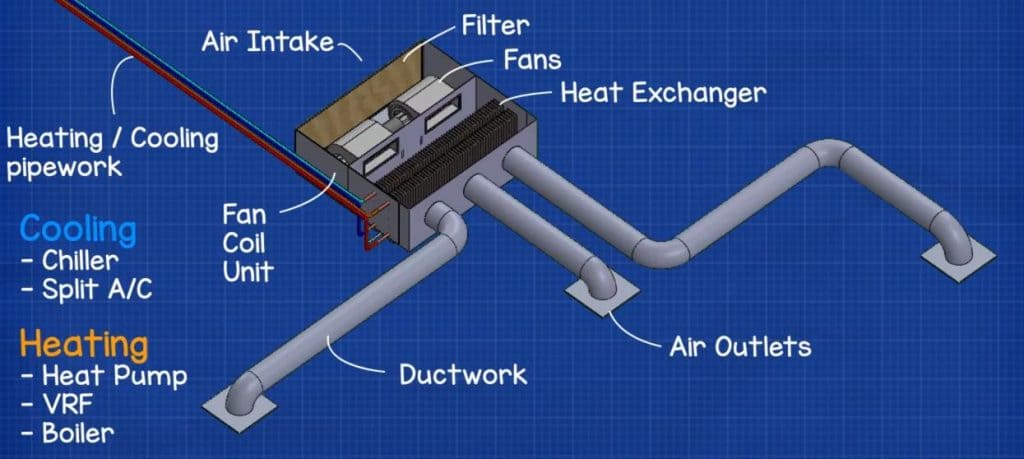
We’ve covered Air handling units, rooftop units and fan coils in detail in our previous articles. Do check those out HERE.
Extract ventilation
We’re going to have some bad odours generated in the building from places such as toilets, food preparation areas as well as car parks. This air needs to be extracted from the building, so these will be connected to dedicated exhaust systems. We might find several of these areas connected into one system or a separate extract for each one. There are various different fans used but one of the most common and simplest designs is to use a centrifugal type fan like this. The fan uses a belt driven motor to rotate the fan blades and create a pressure difference, this will suck the air in on one side and force it out the other.
For staff areas or smaller stores we might find a gas boiler system providing heating through radiators and trench heaters. In the most basic system we find a circulation pump pushing water around the closed system, picking up heat from the gas fired boiler and delivering this to the radiators. Despite the name, radiators actually dissipate their heat through natural convection not radiation.
Some stores will also use refrigeration systems to providing space heating and cooling, these will use systems like VRF, split AC as well as heat pumps.
Split Air Conditioning
Split AC is the simplest type; it’s just a vapour compression system which uses a compressor, a condenser, an expansion valve and an evaporator. The compressor pushes the refrigerant around the system to collect the unwanted heat from the evaporator and bring this over to the condenser. The refrigerant has a very low boiling point so as it enters the evaporator, the heat of the room will be more than enough to make it will boil and evaporate. As the refrigerant evaporates it collects the unwanted heat and carries it away back to the compressor. As the unwanted heat is collected in the evaporator, it is exchanged for a cooling effect. This type of system will only provide cooling. For more information on split air conditioning CLICK HERE.
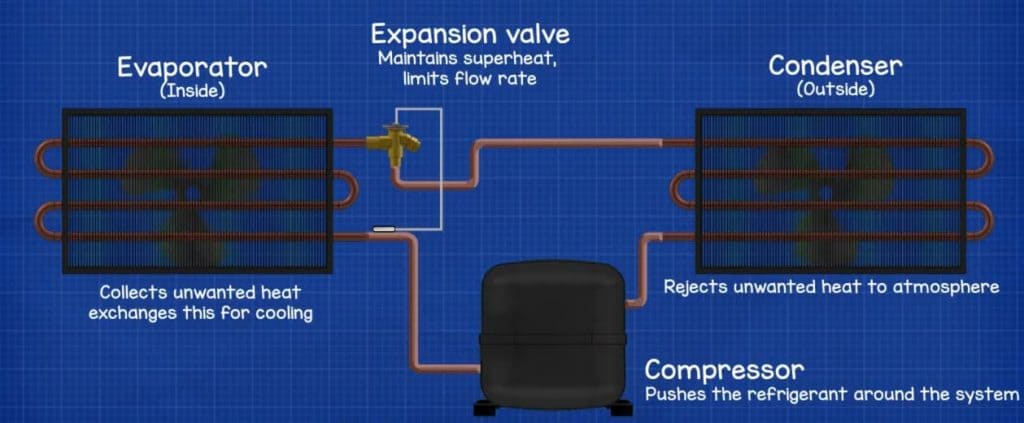
Variable Refrigerant Flow System
The next system we’ll likely find is the VRF or variable refrigerant flow system. This uses a variable speed compressor as well as some electronic controls and sensors to vary the amount of refrigerant flowing around the system in order to match the cooling load. This allows the unit to provide cooling to multiple locations simultaneously although again this version only provides cooling.
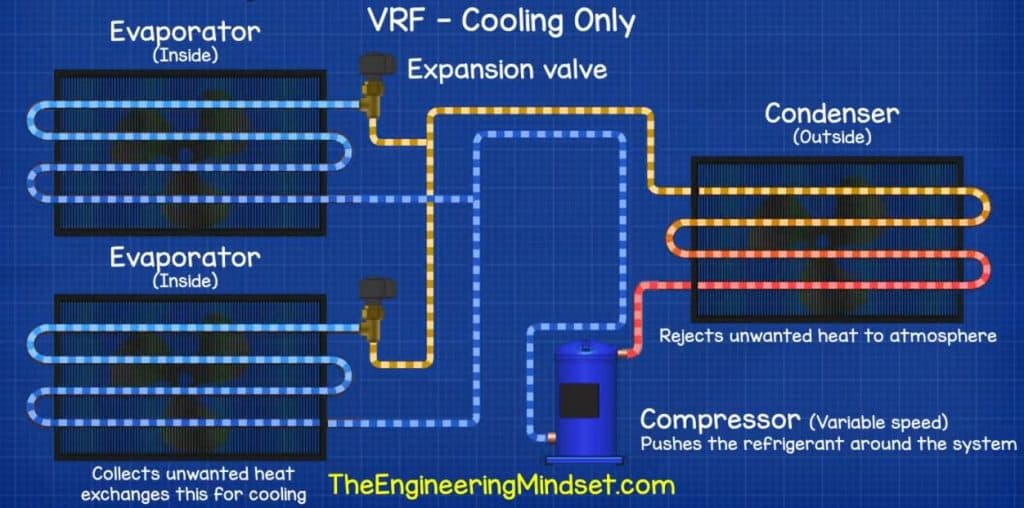
Heat Pumps
The next variation is the heat pump, this allows the unit to provide cooling or heating, it can switch between cooling and heating but it can only provide one of these at a time. It does this by utilising the reversing valve. This diverts the hot discharge refrigerant from the compressor, to either the outdoor unit or the indoor unit depending on whether the unit is in heating or cooling mode. There will likely be multiple expansion valves as well as non-return valves to ensure the refrigerant flows along the correct pipes.
In cooling mode it operates like a normal cooling system, collecting the heat from the indoor unit and dissipating this to atmosphere via the outdoor unit.
In heating mode the system operates in reverse, collecting heat from outdoors and dissipating this indoors. The boiling point of the refrigerant is extremely low so even the outside air in winter can cause it to boil and evaporate. Even when it’s cold outside, the air, in most cases, will still contain enough thermal energy to boil the refrigerant and therefore provide heating.
For more information on heat pumps CLICK HERE.
VRF Heat Recovery System
Another very common system we find is the VRF heat recovery system. This uses variable speed compressors as well as multiple electronic sensors, valves and controls to provide both heating and cooling at the same time, to different parts of the building.
In cooling mode the VRF unit operates like any split AC unit, absorbing heat from indoors and dissipating this via the external outdoor heat exchanger.
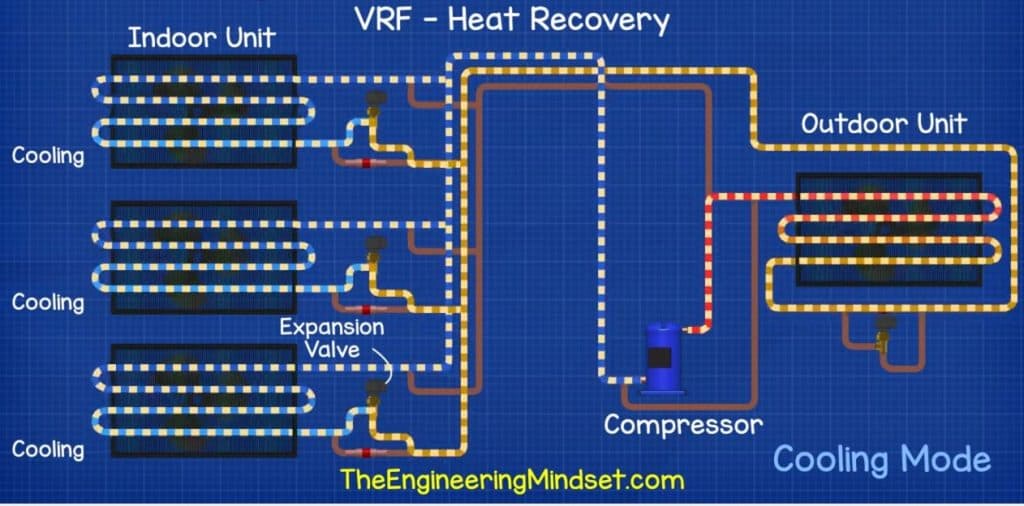
In heating mode it operates like a heat pump, picking up thermal energy from the outside ambient air and transferring this into the indoor heat exchangers.
In mixed mode the system can provide cooling in the normal refrigeration cycle, but it can also send heat from the compressor discharge and channel this indoor to provide heating. After the refrigerant has provided heating, it can also then flow into another unit to provide cooling.
What About Food Storage?
Well we’re almost certainly going to find a cold store in most supermarkets and these really vary in size. These use a refrigeration system with an externally located condenser and compressor to extract the unwanted heat from the food within the store room and dissipate this to atmosphere. This diagram shows just a basic system but many now come with electronic control valves, sensors and speed controlled compressors to maximise the efficiency. For more information on cold rooms CLICK HERE
When it comes to the shop floor we will likely find some display refrigerators. This stand alone type usually has a small and simple vapour compression refrigeration system which is compactly installed under the unit, sometimes the condenser is mounted to the back of the fridge and doesn’t use a fan. The expansion valve might be just a capillary tube on very basic units but newer more efficient ones will use electronic controls. This all in one, plug and play design allows the fridge to be moved around the store very easily but the heat it removed from inside the refrigerator as well as the heat from the compressor, is simply discharged into the store, so this will increase the heat load and cause the space cooling to work harder.
Larger refrigerators will likely use an external condenser and compressor. This is a better option because it completely removes the heat from the refrigerator and also the space and then dissipates this into the atmosphere which is more efficient, however, the refrigerator is fixed in place.
What About Larger Stores?
Larger stores with aisles of refrigerators and maybe some freezers too will likely use centralised refrigeration systems. These could be a booster system where the refrigerant is split between different temperature lines and then the low temperature refrigerant is boosted using a secondary compressor.
It could also be a parallel system which uses another compressor in parallel to recycle some of the vapour from the receiver. A growing trend is to now use transcritical CO2 refrigeration systems and these will often use a multi ejector to improve the operation and climates it can be installed in.
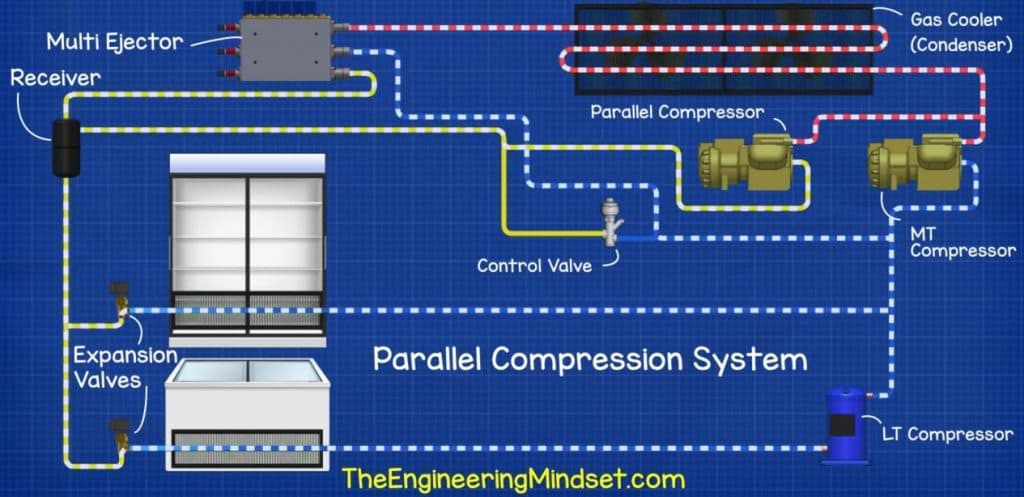
We might even find some cascade type systems in the largest stores or on industrial scale sites. For more information on industrial refrigeration CLICK HERE.

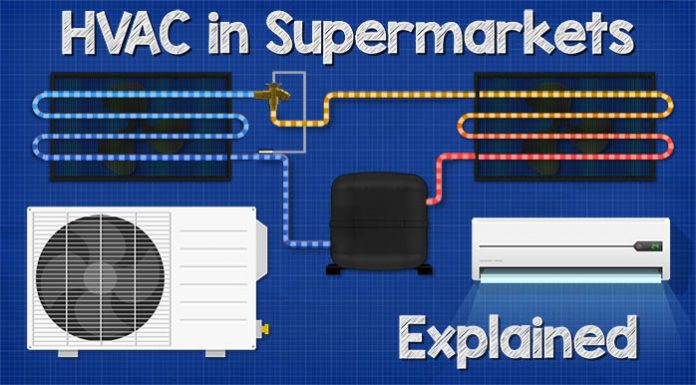





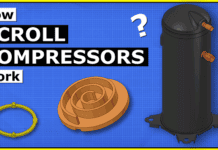
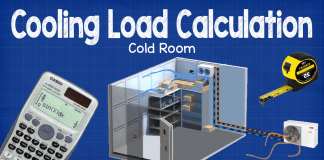

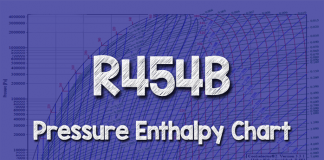

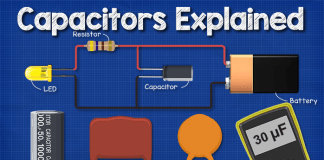
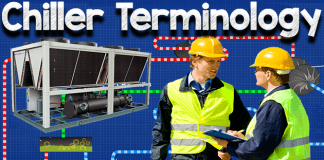








Can the systems conduct viruses, etc.?
What provisions are made for sanitation, uV light, etc.?
Thanks very much.
Tom
Nice! The information I got through this blog has really helped me in understanding detailed knowledge of humidifier that was something, I was desperately looking for, thankfully i found this at the right time.
It really stood out to me when you pointed out that large supermarkets will use a centralized refrigeration system. I would imagine that it would be important to keep the refrigerators upgraded themselves as well. Keeping the cooling systems upgraded will help you deliver a better product to your customers.
Nice read, Poul. I have got all the necessary information about the different HVAC systems that I have been searching on the web for the last 2 days. Thanks for sharing.
[…] Image Source: https://theengineeringmindset.com/supermarket-hvac-basics-explained/ […]